The Fear and Greed Index assesses the sentiment of the cryptocurrency market from 0 to 100. It is based on "Index of Fear and Greed" CNNMoney for stock market analysis.
Fear (0 to 49) indicates low prices and oversupply in the market, while greed (50 to 100) suggests overvaluation of cryptocurrencies and the possible formation of a bubble.
Noticeable changes in the level of fear and greed will be important when planning a trading strategy when entering or exiting the cryptocurrency market.
A good trader or investor will always look for additional information that they can rely on when making decisions about buying or selling cryptocurrency. There are many indicators that you need to pay attention to: charts, fundamentals, market sentiment, etc. Note that studying absolutely all available indicators is not the most effective use of your time. Thus, the combination of market sentiment and fundamentals allows us to get an idea of the level of fear and greed. However, you should not rely solely on this indicator. It is worth using to better gauge the overall sentiment in the cryptocurrency markets.
What is an index?
Traditionally, an index is a statistical measure based on multiple data points. You've probably already heard of the Dow Jones Industrial Average (DJIA), which tracks the stock market. The DJIA is a composite of the stock prices of 30 major companies listed on numerous U.S. stock exchanges. Traders and investors can buy the DJIA to gain exposure to shares of all of these companies.
The Fear and Greed Index is also a weighted measure of market data, but that's where the similarities end. This index is not a commodity or any financial instrument. It is simply a market indicator that can help you in your analysis.
“Don’t get emotional and follow your strategy if you want to make money”
The emotional state of a trader and investor is actually the first and most important factor that influences his decisions. If a trader is nervous, afraid, trying to “win back” or is overly self-confident, this most often leads to a loss of capital.
Today, more than 60-70% of trading volume on exchanges is carried out by programs, since they are emotionless and work strictly in accordance with the strategy and in a given algorithm. It is worth noting that algorithms bring more profit and more often than traders. As for investing rather than trading, emotions interfere a little less here, but they can force an investor to sell assets earlier or buy too late.
Even more business in our Telegram channel. Subscribe!
You need to remember that facts don’t care about your feelings and emotions. It is necessary to focus on the investment strategy, to believe in numbers, facts and statistics, and not in “fear indexes” or bloggers. Run and shout “Chief, everything is gone!” definitely not worth it. In this case, the chances of success increase significantly.
My advice: look at the “fear index” - do the opposite. If it goes off scale, in my opinion, it’s time to buy. If the “greed index” is off the charts, it would be a good idea to prepare for sales.
The message contains information about market movements, is not investment research, should not be considered as investment advice and is a subjective point of view of the subject of the message of the author of the material. Past performance is not a reliable indicator of future price movements.
Attention! Investments involve the risk of loss of the entire investment. The success of past investments does not mean future success.
Understanding the Fear and Greed Index
CNNMoney originally proposed an index of fear and greed to analyze market sentiment regarding stocks. Based on it, Alternative.me created their own version, adapted for the cryptocurrency market.
The Fear and Greed Index analyzes various market trends and indicators to determine whether market participants are experiencing greed or fear. A score of 0 indicates extreme fear and 100 indicates extreme greed. A score of 50 indicates that the market is relatively neutral.
High fear in the market indicates that cryptocurrencies are undervalued. This could lead to massive selling of currencies and excessive panic. However, fear does not necessarily mean that the market is in a long-term bearish trend. It should be considered as a short-term or medium-term snapshot of market sentiment.
Greed in the market is the opposite situation. If investors and traders are greedy, there is a possibility of overvaluation and a bubble. Imagine a situation where FOMO prompts investors to stimulate markets, thereby overestimating the value of Bitcoin. That is, increased greed can lead to excess demand, which artificially inflates the price.
The Fear and Greed Index uses a scale from 0 to 100. The higher the number, the more greedy investors are, with 50 indicating investors are neutral. To give some historical context, on September 17, 2008, at the height of the financial crisis, the Fear and Greed Index hit a low of 12.
Seven different indicators are used to calculate the fear and greed index.
The CNN tracks how much each indicator has deviated from its mean compared to how much it typically deviates. Each indicator is then given equal weight when it comes to the final value. Here are the seven entrances.
- Stock Price Momentum: S&P 500 versus its 125-day moving average. By looking at the equity benchmark against its own history, you can measure how the 500 companies in the index are valued.
- Stock Price Strength: Number of stocks hitting 52-week highs and lows on the New York Stock Exchange. Stock prices of public companies can signal whether they are overvalued or undervalued.
- Stock price spread: The volume of shares traded in a stock is rising relative to stocks that are falling. Market range can be used to assess the prevalence of bullish or bearish sentiment.
- Put and call options The ratio of bullish call option trades to bearish put option trades. Options give the right, not the obligation, to buy or sell an asset. Thus, an increase in the number of calls instead of puts may indicate that investors are optimistic about purchasing shares in the future.
- Demand for junk bonds: the difference between the yield of investment grade bonds and junk or high yield bonds. Bond prices move in the opposite direction of yields. So when yields on higher-quality investment-grade bonds rise relative to those on junkier debt, investors seek out riskier assets.
- Market volatility. The Cboe Volatility Index, also known as the VIX, is designed to track investors' expectations for volatility over a 30-day period. Rising expectations of stock market turbulence may be an indicator of fear.
- Safe harbor demand: Differences in stock and treasure returns. The extent to which investors favor riskier markets such as stocks over safer assets such as U.S. government bonds can indicate sentiment.
How to read VIX
The correlation between the VIX and the S&P 500 is quite clear. Let's compare the values for the third quarter of 2012, where the blue line is the S&P 500 and the red line is the VIX.
As you can see, a decrease in VIX (complacency) corresponds to an increase in the S&P 500, and an increase in VIX (fear), on the contrary, is a signal for a collapse in the S&P 500.
Statistics show that the VIX and the S&P 500 are inversely correlated, as between 2000 and 2012 the VIX moved in the opposite direction of the S&P 500 more than 80% of the time.
Where the VIX peaks, there is a decline in the S&P 500 and all the associated effects that affect both the dollar and other currencies.
So:
- if VIX is less than 20 , investors are less worried, S&P 500 volatility is expected to be low;
- if the VIX is greater than 30 , investor fear increases as S&P 500 option prices rise; therefore, investors pay more to hedge their assets.
A typical picture is, say, the VIX at an ultra-low 9.3 and the S&P 500 hitting new record gains. These are all indications of an impending collapse in the S&P 500. However, if Central Banks (whose news is worth keeping an eye on) change monetary policy accordingly, this VIX level could very well become the new “normal” value.
One of the usage scenarios is to wait for the VIX to consolidate above 30 and enter the SPX when it falls. When investors' fear levels run high, this is an indication of a panic sell-off.
Let's look at real examples. In August 2015, the VIX broke fear records, reaching a high of 28.02 . In theory, this means the SPX index will fall.
But why in theory? In practice, everything worked 100%; the SPX index really collapsed impressively.
In the lesson Correlations of Indices and Currency Pairs, we looked at how to use market indices in our work. Because the VIX loves the S&P 500 so much, it can be considered an additional trend indicator for the overall stock market. Let's not forget the fundamental implications of, say, the S&P 500 index being correlated with the value of the US dollar.
What is a market indicator?
Market indicators make it easier for traders and investors to analyze market data. Indicators exist in all forms of market analysis, including technical analysis, fundamental analysis, and sentiment analysis. If you have already experimented with technical analysis (TA), then you probably have experience working with indicators. They range from moving averages to complex chart patterns such as Ichimoku clouds. TA indicators are designed to analyze prices, trading volume and other statistical trends.
Fundamental analysis indicators take a different approach. When researching a token or stock, we are essentially trying to determine the underlying fundamental value of the project. For example, such a study might include the number of users and overall market size in the indicator.
In turn, market sentiment indicators reflect the feelings of investors and traders regarding the market situation. The index of fear and greed is far from the only one. Other examples include Augmento's Bull and Bear Index and WhaleAlert, which tracks large whale transfers in cryptocurrency markets. Crypto research relies heavily on social media, community, and public opinion analysis. This is why sentiment analysis can be useful for this asset class.
How to Use FGI for Regular Trades
Classic market psychology believes that the market always moves against the crowd, that is, according to the theses of the famous Buffett, one must be careful when everyone is “greedy” and take risks (“greedy”) when most are afraid to trade. Hence the conclusion:
- Fear > need to sell > increase in supply > decrease in price
- Greed > need to buy > high demand > rising prices
In fact, it turns out that the index only shows the “market” past and will always lag, especially in the cryptocurrency market. By the time he informs you about the new “fear,” social networks will already be panicking with all their might, the major players will have time to dump all their volumes, and you will only have time to jump into such a market at the very end, and this is very dangerous.
It is assumed that:
- if the market falls and assets become cheaper, then the index will show “fear”, and we are recommended to buy.
- if the market is overbought (“overheated”) and requires correction, the index will shift towards “greed” - it is recommended to sell, or even better, to stay out of the market.
In real time, the index can be interpreted as an independent volatility indicator:
- less than 20% – weak, the market is optimistic;
- 20−40% - standard, risk appetite decreases;
- 40-60% – average, fears of a market collapse are growing;
- more than 40% - panic in the market.
Become a trader with market leader broker RoboForex
How does the fear and greed index work?
Alternate.me calculates a new value from 0 to 100 every day. As of July 2022, the Fear and Greed Index is based on Bitcoin-specific information only, as BTC is significantly correlated with the overall cryptocurrency market when it comes to price and sentiment. In the future, the index will also reflect the market situation of other major coins, including Ether (ETH) and BNB.
The index scale can be divided into several categories:
- 0–24: severe fear (orange)
- 25–49: fear (yellow)
- 50–74: Greed (light green)
- 75–100: strong greed (green)
The index calculates value by combining five market factors in certain proportions. Let's take a closer look:
- Volatility (25% of the index). Volatility reflects the average price of Bitcoin over the last 30 and 90 days. Here volatility is used as a substitute for uncertainty in the market.
- Market momentum/volume (25% of index). Bitcoin's current trading volume and market momentum are compared to previous 30- and 90-day averages and then combined. Constant purchases in large volumes indicate greed or positive market sentiment.
- Social networks (15% of the index). This factor analyzes the number of Bitcoin-related hashtags on Twitter and how fast they spread. As a rule, unusually active hashtag distribution is associated with increased greed in the market.
- Bitcoin dominance (10% of the index). This factor reflects the dominance of BTC in the market. Increasing market dominance indicates new investments in the coin and a possible reallocation of funds from altcoins.
- Google Trends (10% of the index). By analyzing Google Trends data on Bitcoin search queries, you can get an idea of market sentiment. For example, an increase in the number of queries related to “bitcoin fraud” will indicate increased fear in the market.
- Survey results (15% of the index). This option has not been used for some time and is currently suspended.
How is the Fear and Greed Index useful?
The Fear and Greed Index can be a valuable tool for tracking changes in market sentiment. During large swings, there may be an opportunity to get in and out before the rest of the market follows the trend. An example of this can be seen by comparing the total cryptocurrency market capitalization over the last three months with index data.
Point 1 shows the value from April 26, 2022, when the lowest value of the index swing from 73 (greed) to 27 (fear) was reached. Point 2 shows the swing spike from May 12, 2022 from 68 (greed) to 26 (fear). You can check whether this corresponds to the real situation on the cryptocurrency market by comparing these changes with the total capitalization of the cryptocurrency market.
Here, point 1 again shows April 26: the chart rises from $1.78 trillion (USD) to a peak of $2.53 trillion on May 12. If we combine these and previous indicators, we will see a sharp jump in sentiment from greed to fear, coinciding with the local bottom of the cryptocurrency market capitalization. As the market gets greedier, the overall market capitalization rises to its peak before sentiment plummets again.
In our example, the index was extremely useful in identifying buying opportunities and predicting market sell-offs. Using an index, you can check whether your expectations from the market are justified and how they correspond to the current situation. But will the index of fear and greed be useful in any situation? Most likely no.
Do's and Don'ts of Using the Fear and Greed Index
How is the Fear and Greed Index useful? For the same reason why it can be useful to check the temperature of any parameter.
Measuring how hot or cold it is can help determine what move you want to make next as an investor. Are you too greedy? Too scary? Is it time to think about the herd mentality?
It is also common for some investors to often try to be contrarian, so when markets seem frothy and the rest of the herd appears to be overvaluing assets, investors try to sell, and vice versa.
Do
Use the index to understand that investing can be emotional, but it shouldn't be.
Use it to determine when to enter the market. Say, for example, you're looking at a stock that's becoming even more undervalued as investor fears rise, it could be a good time to buy the stock.
Not to do
- Do not rely solely on the Fear and Greed Index or other measures of investor sentiment as the sole factor in making investment decisions.
- The fundamentals—like how much the economy is growing or how quickly the companies in your portfolio are growing revenue and earnings—are important.
For example, at some point the FGI may signal extreme greed, with all seven indicators also reflecting greed. However, this extreme optimism may be justified if the economy is running at full capacity, allowing companies to hire and consumers to buy goods.
What is stock market volatility
When the index falls, investors' fears about a possible stock market crash decrease and greed increases.
The Russian market has its own volatility index (RVI). It is calculated based on the volatility of real prices of options on the RTS index.
RVI and the RTS index have an inverse correlation: the higher the RTS, the lower the RVI and the greedier investors are
Can this index be used for long-term analysis?
The indicator does not perform as effectively in long-term analysis of cryptocurrency market cycles. During bullish or bearish periods, the market goes through several cycles of fear and greed. These changes are generally beneficial for swing traders, but investors looking to hold funds will have a difficult time predicting market movements based on this index. In this case, you will have to analyze other aspects of the market to get the overall picture and trends for the future.
Naturally, we recommend not relying on just one indicator or analysis style. Be sure to do your own research (DYOR) before investing, and always invest only what you are willing to lose.
Conclusion
The Fear and Greed Index is a simple way to collect and summarize a range of fundamental indicators, including market sentiment. You can also use the indicator to track social media, Google Trends, and other statistics so you don't have to collect this data yourself. If you do intend to include this indicator in your analysis, try to supplement it with other metrics to get the most balanced and objective result.
The Fear and Greed Index is one of many indicators that track investor sentiment. Investors typically use it to get a contrarian view of the markets, so when the rest of the herd seems scared, they buy or, if greedy, sell. While it can be a useful tool in determining the timing of certain investments, it should not be used as the sole determining factor in making investment decisions.
Ready to buy and sell stocks, ETFs, fractional shares or cryptocurrency on your own? Online trading with SoFi Invest offers an active investing platform where investors can make their own decisions about how they want to structure their portfolios. If choosing your own investments isn't for you, the automated investing service takes your preferences into account and manages a diversified portfolio for you.










